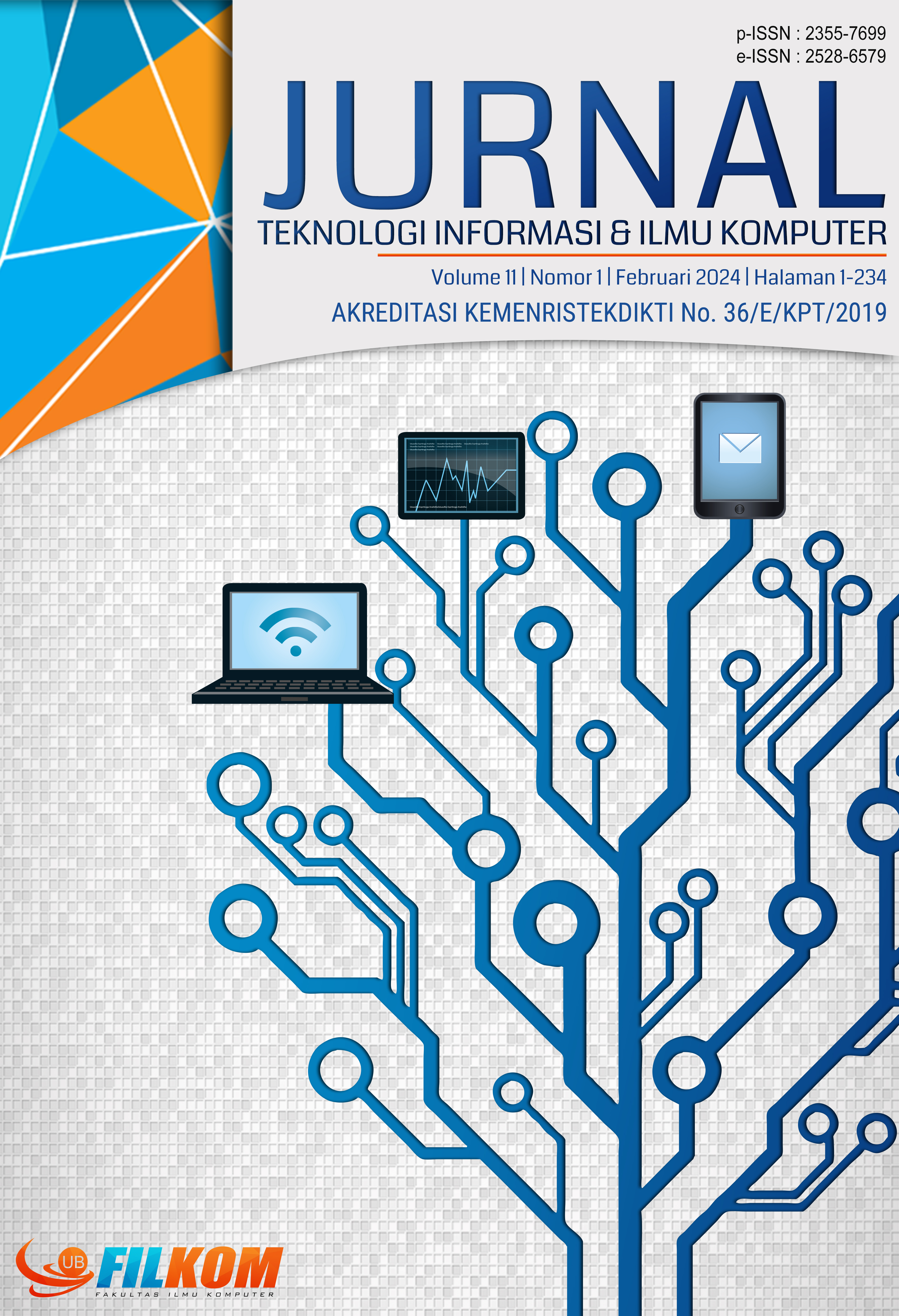Integrasi Audit Trail dan Teknik Clustering untuk Segmentasi dan Kategorisasi Aktivitas Log
DOI:
https://doi.org/10.25126/jtiik.20241118071Kata Kunci:
Audit Trail, Clustering, K-Means, Analisis LogAbstrak
Dengan berkembangnya teknologi, organisasi dan perusahaan kini mengumpulkan data dalam jumlah yang sangat besar, yang tercatat dalam log sistem untuk tujuan audit keamanan, pemantauan, dan investigasi forensik. Namun, tantangan utama muncul saat analis keamanan harus menangani volume data log yang besar, yang seringkali membuat sulit untuk mengidentifikasi aktivitas mencurigakan atau abnormal. Dalam upaya mengatasi tantangan analisis log yang berskala besar dalam sistem informasi, penelitian ini bertujuan untuk mengintegrasikan teknik audit trail dengan metode clustering, khususnya menggunakan K-Means, untuk segmentasi dan kategorisasi aktivitas log. Penelitian ini mencari pendekatan yang dapat meningkatkan efisiensi dalam menelusuri dan menganalisis log aktivitas dengan mengelompokkan data log yang serupa. Metode yang digunakan mencakup desain eksperimental, pengumpulan data audit trail yang komprehensif, preprocessing data, implementasi algoritma K-Means, dan evaluasi hasil clustering. Hasil penelitian mengindikasikan bahwa penerapan K-Means pada audit trail memungkinkan identifikasi pola aktivitas yang signifikan, memudahkan deteksi anomali dengan cepat, dan menyederhanakan proses audit keamanan data, yang mengarah pada pemahaman yang lebih baik dalam pengelolaan risiko keamanan informasi.
Downloads
Referensi
ALAHMARI ADEF, M. A., AL MOALEEM BG, M. M., HAMDI BG, B. A., ABDULAZIZ HAMZI, M. B., TALAJ ALJADAANI ABCDG, A., ALI KHORMI, F. B., AHMED DARRAJ BFG, M., SHRWANI BFG, R. J., AHMED ALOMAR, A. B., KINANI TAHHAH ACDEF, M., ALYOUSEFY ACEF, M. A., AL SANABANEI, F. A., & AL MOALEEM, M. M. (2022). Prevalence of Burnout in Healthcare Specialties: A Systematic Review Using Copenhagen and Maslach Burnout Inventories. https://doi.org/10.12659/MSM.938798
BOUSKILL, K. E., DANZ, M., MEREDITH, L. S., CHEN, C., CHANG, J., BAXI, S. M., HUYNH, D., AL-IBRAHIM, H., MOTALA, A., LARKIN, J., AKINNIRANYE, O., & HEMPEL, S. (2022). Burnout Definition, Prevalence, Risk Factors, Prevention, and Interventions Literature Reviews Research Report. www.rand.org/about/principles.
BUDI DARMA. (2021). STATISTIKA PENELITIAN MENGGUNAKAN SPSS (Uji Validitas, Uji Reliabilitas ... - Budi Darma - Google Books. https://books.google.co.id/books?hl=en&lr=&id=acpLEAAAQBAJ&oi=fnd&pg=PA3&dq=menggunakan+uji-t+independen&ots=IYr6ZXisZ7&sig=5pPD41TawH8X2pA5U-spUOM7-yw&redir_esc=y#v=onepage&q=menggunakan%20uji-t%20independen&f=false
BYKOV, K. V., ZRAZHEVSKAYA, I. A., TOPKA, E. O., PESHKIN, V. N., DOBROVOLSKY, A. P., ISAEV, R. N., & ORLOV, A. M. (2022). Prevalence of burnout among psychiatrists: A systematic review and meta-analysis. Journal of Affective Disorders, 308, 47–64. https://doi.org/10.1016/J.JAD.2022.04.005
CALDERÓN-DE LA CRUZ, G. A., MERINO-SOTO, C., JUÁREZ-GARCÍA, A., DOMINGUEZ-LARA, S., & FERNÁNDEZ-ARATA, M. (2020). Is the factorial structure of the Maslach Burnout Inventory Human Service Survey (MBI-HSS) replicable in the nursing profession?: a national study profession in Peru? A national study. Enfermería Clínica, 30(5), 340–348. https://doi.org/10.1016/J.ENFCLI.2019.12.013
GUSEVA CANU, I., MARCA, S. C., DELL’ORO, F., BALÁZS, Á., BERGAMASCHI, E., BESSE, C., BIANCHI, R., BISLIMOVSKA, J., BJELAJAC, A. K., BUGGE, M., BUSNEAG, C. I., ÇAĞLAYAN, Ç., CERNITANU, M., PEREIRA, C. C., HAFNER, N. D., DROZ, N., EGLITE, M., GODDERIS, L., GÜNDEL, H., … WAHLEN, A. (2021). Harmonized definition of occupational burnout: A systematic review, semantic analysis, and Delphi consensus in 29 countries. Scandinavian Journal of Work, Environment and Health, 47(2), 95–107. https://doi.org/10.5271/sjweh.3935
KIM, H. D., PARK, S. G., KIM, W. H., MIN, K. B., MIN, J. Y., & HWANG, S. H. (2021). Development of Korean Version Burnout Syndrome Scale (KBOSS) Using WHO’s Definition of Burnout Syndrome. Safety and Health at Work, 12(4), 522–529. https://doi.org/10.1016/j.shaw.2021.08.001
LEE, S. W. (2022). Methods for testing statistical differences between groups in medical research: statistical standard and guideline of Life Cycle Committee. Life Cycle, 2. https://doi.org/10.54724/LC.2022.E1
LIN, C.-Y., ALIMORADI, Z., GRIFFITHS, M. D., & PAKPOUR, A. H. (2017). Psychometric properties of the Maslach Burnout Inventory for Medical Personnel (MBI-HSS-MP). Heliyon, e08868. https://doi.org/10.1016/j.heliyon.2022.e08868
LIU, Q., & WANG, L. (2020). t-Test and ANOVA for data with ceiling and/or floor effects. https://doi.org/10.3758/s13428-020-01407-2
PALUPI, R., YULIANNA, D. A., & WINARSIH, S. S. (2021). Analisa Perbandingan Rumus Haversine Dan Rumus Euclidean Berbasis Sistem Informasi Geografis Menggunakan Metode Independent Sample t-Test. JITU : Journal Informatic Technology And Communication, 5(1), 40–47. https://doi.org/10.36596/jitu.v5i1.494
WICKRAMASINGHE, N. D., DISSANAYAKE, D. S., & ABEYWARDENA, G. S. (2018). Validity and reliability of the Maslach Burnout Inventory-Student Survey in Sri Lanka. BMC Psychology, 6(1), 1–10. https://doi.org/10.1186/S40359-018-0267-7/FIGURES/1
Unduhan
Diterbitkan
Terbitan
Bagian
Lisensi
Hak Cipta (c) 2024 Jurnal Teknologi Informasi dan Ilmu Komputer

Artikel ini berlisensiCreative Commons Attribution-ShareAlike 4.0 International License.

Artikel ini berlisensi Creative Common Attribution-ShareAlike 4.0 International (CC BY-SA 4.0)
Penulis yang menerbitkan di jurnal ini menyetujui ketentuan berikut:
- Penulis menyimpan hak cipta dan memberikan jurnal hak penerbitan pertama naskah secara simultan dengan lisensi di bawah Creative Common Attribution-ShareAlike 4.0 International (CC BY-SA 4.0) yang mengizinkan orang lain untuk berbagi pekerjaan dengan sebuah pernyataan kepenulisan pekerjaan dan penerbitan awal di jurnal ini.
- Penulis bisa memasukkan ke dalam penyusunan kontraktual tambahan terpisah untuk distribusi non ekslusif versi kaya terbitan jurnal (contoh: mempostingnya ke repositori institusional atau menerbitkannya dalam sebuah buku), dengan pengakuan penerbitan awalnya di jurnal ini.
- Penulis diizinkan dan didorong untuk mem-posting karya mereka online (contoh: di repositori institusional atau di website mereka) sebelum dan selama proses penyerahan, karena dapat mengarahkan ke pertukaran produktif, seperti halnya sitiran yang lebih awal dan lebih hebat dari karya yang diterbitkan. (Lihat Efek Akses Terbuka).















